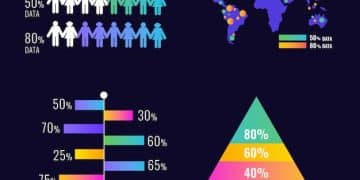Progressive Era Reforms: Shaping US Government & Society in 2025

The Progressive Era reforms, designed to address industrialization and urbanization issues, continue to shape the US government and society in 2025 through their influence on regulatory frameworks, social welfare programs, and democratic processes.
The How Did the Progressive Era Reforms Shape US Government and Society in 2025? is a question that invites a deep look into the past to understand our present. The reforms enacted during this period have left an indelible mark on how the United States is governed and how its people live.
Understanding the Progressive Era and Its Core Principles
The Progressive Era, which spanned from the 1890s to the 1920s, was a time of significant social and political upheaval in the United States. It emerged as a response to the vast inequalities and injustices brought about by rapid industrialization, urbanization, and immigration.
At the heart of the Progressive Era was a deep desire to improve society and the lives of ordinary Americans. Progressives sought to address a wide range of issues, from corruption in government and business to poverty, inequality, and social injustice.
Key Goals of the Progressive Movement
Progressives aimed to reform various aspects of American life, focusing on several key areas. These goals continue to resonate in the policies and structures of the US government and society in 2025.
- Political Reform: Aiming to eliminate corruption and make government more responsive to the people through measures like direct primaries, the initiative, referendum, and recall.
- Economic Reform: Seeking to regulate big business, protect consumers and workers, and promote fair competition through antitrust laws and labor protections.
- Social Welfare: Working to alleviate poverty, improve living conditions, and provide social services to those in need through settlement houses, social insurance programs, and public health initiatives.
- Moral Reform: Advocating for temperance, moral purity, and the assimilation of immigrants into American society through prohibition and other moral regulations.
The reforms of the Progressive Era were not without their complexities and contradictions. While progressives sought to improve society, they often disagreed on the best path forward, and their efforts sometimes had unintended consequences. Nevertheless, the Progressive Era left a lasting legacy on American government and society.
The Lasting Impact on Government Structure
One of the most significant legacies of the Progressive Era is its impact on the structure and function of the US government. Progressives enacted several key reforms that fundamentally altered the relationship between the government and the people.
These reforms aimed to make the government more transparent, accountable, and responsive to the needs of ordinary citizens. Many of these changes are still evident in 2025, shaping how the government operates at all levels.
Direct Democracy and Citizen Participation
Progressives advocated for direct democracy measures to give citizens a more direct role in government. These included initiatives, referendums, and recalls, which allow citizens to propose and vote on laws, as well as remove elected officials from office.
In 2025, these tools are used in many states and localities to address issues ranging from taxation and education to environmental protection and social policy. The ability of citizens to directly influence policy decisions remains a cornerstone of American democracy.

Expansion of Federal Regulatory Power
The Progressive Era saw a significant expansion of federal regulatory power, as the government sought to rein in the excesses of big business and protect consumers and workers. The creation of agencies like the Food and Drug Administration (FDA) and the Federal Trade Commission (FTC) laid the groundwork for modern regulatory oversight.
In 2025, these agencies continue to play a crucial role in ensuring the safety and quality of products and services, as well as promoting fair competition and protecting consumers from fraud and abuse. Their regulatory powers have expanded to address new challenges, such as those posed by the digital economy and climate change.
The Progressive Era’s impact on government structure is profound. It shifted the balance of power, empowering citizens and expanding the role of government in regulating the economy and protecting the public interest. These changes continue to shape the American political landscape today.
Economic Reforms and Their Relevance Today
The economic landscape of the United States was significantly reshaped by the reforms of the Progressive Era. These reforms were designed to address the vast inequalities and injustices that arose during the rapid industrialization of the late 19th and early 20th centuries.
From antitrust legislation to labor protections, the economic reforms of the Progressive Era sought to create a fairer and more equitable economic system. These reforms continue to influence economic policy and business practices in 2025.
Antitrust Legislation and Competition
One of the most important economic reforms of the Progressive Era was the passage of antitrust legislation, such as the Sherman Antitrust Act of 1890 and the Clayton Antitrust Act of 1914. These laws were designed to prevent monopolies and promote competition in the marketplace.
In 2025, antitrust enforcement remains a critical tool for preventing anti-competitive behavior and protecting consumers from price-fixing, market manipulation, and other forms of abuse. Government agencies continue to investigate and prosecute companies that violate antitrust laws, ensuring a level playing field for businesses of all sizes.
Labor Protections and Workers’ Rights
Progressives also fought for labor protections and workers’ rights, seeking to improve working conditions and protect employees from exploitation. These efforts led to the passage of laws regulating child labor, limiting working hours, and establishing minimum wage standards.
In 2025, labor laws continue to provide essential protections for workers, safeguarding their health, safety, and economic well-being. While the nature of work has changed significantly since the Progressive Era, the fundamental principles of fair labor practices and workers’ rights remain relevant and continue to be debated and refined.
- The fight for a living wage
- Paid family leave and sick days
- The right to organize and bargain collectively
The economic reforms of the Progressive Era laid the groundwork for a more regulated and equitable economic system in the United States. These reforms continue to shape economic policy and business practices today, ensuring that the benefits of economic growth are more widely shared.
Social Welfare Programs: A Progressive Legacy
The Progressive Era marked a turning point in the development of social welfare programs in the United States. Progressives recognized that government had a responsibility to provide a safety net for those in need, and they advocated for a range of social reforms aimed at alleviating poverty, improving living conditions, and promoting social justice.
The social welfare programs established during the Progressive Era laid the foundation for the modern welfare state, which continues to provide essential support to millions of Americans in 2025.

Early Social Insurance Programs
Progressives pioneered the concept of social insurance, which provides protection against economic risks such as unemployment, disability, and old age. Several states enacted workers’ compensation laws during the Progressive Era, providing benefits to workers injured on the job.
These early experiments with social insurance paved the way for the Social Security Act of 1935, which established a national system of old-age insurance and unemployment compensation. In 2025, Social Security remains the cornerstone of the American social safety net, providing vital income support to retirees, the disabled, and survivors of deceased workers.
Public Health Initiatives
Progressives also championed public health initiatives aimed at improving sanitation, preventing disease, and promoting healthy lifestyles. These efforts led to the establishment of public health departments, the regulation of food and drugs, and the implementation of vaccination programs.
In 2025, public health agencies continue to play a critical role in protecting the health and well-being of the population. They monitor disease outbreaks, promote preventive care, and respond to public health emergencies, such as pandemics and natural disasters.
The social welfare programs of the Progressive Era have had a lasting impact on American society, providing a crucial safety net for those in need and promoting a more just and equitable society. These programs continue to evolve and adapt to meet the changing needs of the population, ensuring that all Americans have access to basic necessities and opportunities for upward mobility.
Moral Reforms and Social Regulations
The Progressive Era was also a time of intense moral reform and social regulation. Progressives sought to address what they saw as the moral ills of society, such as alcohol abuse, prostitution, and corruption in politics and business.
These efforts led to the passage of laws regulating personal behavior, restricting immigration, and promoting the assimilation of immigrants into American society. While some of these reforms were well-intentioned, they also had unintended consequences and reflected the biases and prejudices of the time.
Prohibition and the Temperance Movement
One of the most prominent moral reforms of the Progressive Era was the prohibition of alcohol. Progressives believed that alcohol was a major cause of poverty, crime, and domestic violence, and they advocated for a nationwide ban on the manufacture, sale, and transportation of alcoholic beverages.
The 18th Amendment to the Constitution, ratified in 1919, established prohibition, but it proved to be highly controversial and difficult to enforce. In 1933, the 21st Amendment repealed prohibition, ending what many saw as a failed experiment in social engineering. However, the legacy of prohibition continues to influence attitudes towards alcohol and other substances in 2025.
Immigration Restriction and Assimilation
Progressives also sought to restrict immigration and promote the assimilation of immigrants into American society. They believed that immigrants posed a threat to American values and institutions, and they advocated for measures to limit immigration and force immigrants to adopt American customs and traditions.
- English-only education
- Citizenship classes
- Americanization programs
These policies had a profound impact on immigrant communities, contributing to discrimination, social isolation, and cultural loss. In 2025, the debate over immigration continues to be a highly contentious issue, with deep divisions over border security, immigration enforcement, and the rights of immigrants.
The moral reforms and social regulations of the Progressive Era reflect the complex and often contradictory nature of progressivism. While progressives sought to improve society, their efforts sometimes resulted in unintended consequences and reinforced existing inequalities.
Challenges and Controversies of Progressive Reforms
While the Progressive Era brought about many positive changes, it was not without its challenges and controversies. The reforms enacted during this period were often met with resistance from powerful interests, such as big business, political machines, and conservative social groups.
Moreover, some progressive reforms had unintended consequences or exacerbated existing inequalities. Understanding these challenges and controversies is essential for evaluating the legacy of the Progressive Era and its relevance in 2025.
Resistance from Powerful Interests
Many progressive reforms threatened the power and privilege of established elites, who fought fiercely to maintain the status quo. Business leaders opposed regulations that limited their profits or restricted their ability to exploit workers. Political bosses resisted efforts to reform corrupt government practices.
These powerful interests used their wealth and influence to lobby against progressive reforms, often successfully blocking or weakening legislation. Even when reforms were enacted, they often faced legal challenges and bureaucratic obstacles, making it difficult to implement them effectively.
Unintended Consequences and Exacerbated Inequalities
Some progressive reforms had unintended consequences that undermined their goals or created new problems. For example, prohibition led to a rise in organized crime and bootlegging, while immigration restrictions exacerbated discrimination and social tensions.
Moreover, some progressive reforms were not universally beneficial, and they sometimes reinforced existing inequalities. For example, some labor protections excluded agricultural workers and domestic servants, who were disproportionately African American and other minority groups.
The challenges and controversies of progressive reforms highlight the complexities of social change and the importance of considering the potential impacts of policies on all segments of society. In 2025, policymakers must learn from the successes and failures of the Progressive Era, ensuring that reforms are carefully designed and implemented to achieve their intended goals without exacerbating existing inequalities.
| Key Concept | Brief Description |
|---|---|
| 🏛️ Government Reform | Increased citizen participation via initiatives, referendums, and recalls. |
| 💼 Economic Regulation | Antitrust laws to curb monopolies and promote fair competition. |
| 🩺 Social Welfare | Early forms of social security and public health initiatives. |
| 🚧 Moral and Social Regulations | Attempted prohibition and efforts to assimilate immigrants. |
Frequently Asked Questions
▼
The Progressive Era ushered in significant government reforms, enhancing citizen participation through measures such as initiatives, referendums, and recall elections, making the government more responsive to public needs.
▼
Social changes during the Progressive Era included advancements in workers’ rights, improvements in public health, and efforts to regulate child labor, all aimed at enhancing the well-being of citizens.
▼
The Progressive Era influenced economic structure by implementing antitrust laws to prevent monopolies, ensuring fairer competition and protecting consumers from unfair business practices, leading to a more equitable system.
▼
Limitations of the Progressive Era reforms included inconsistencies in their application, often overlooking the needs of minority groups and reinforcing existing social inequalities, despite aiming for broad improvements.
▼
Progressive Era ideals remain highly relevant today as they continue inspiring efforts to address social inequality, promote economic justice, and enhance government integrity, reflecting ongoing societal needs and values.
Conclusion
The Progressive Era’s legacy is deeply interwoven into the fabric of modern American government and society. Its reforms continue to shape our political, economic, and social landscape in 2025, reminding us of the ongoing quest for a more just and equitable nation.





